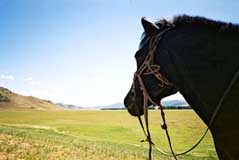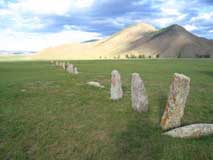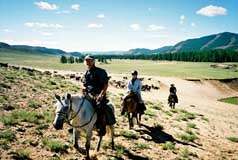The riding experience
At places such as Lake Khovsgol and Karakorum, where there is a relatively well-developed tourism industry, it is possible to stay in comfortable ‘tourist gers’ while riding. But to really experience Mongolia on horse-back it is best to head for more remote areas, camping in tents, cooking over an open fire, and meeting the local people.
History and current situation
Most people are familiar with Mongolia’s glorious past, when Genghis Khan and his horsemen ruled an empire stretching from China to the gates of Europe. But then Mongolia slipped into obscurity, and has only recently re-emerged into the modern world. In 1924 Mongolia became the world’s second communist country, and had a close relationship with Russia until the decline of the Soviet Union in the early 1990s. The country now has a robust democracy, and has embraced the free market. However the shift from communism to a market economy has not been easy, leaving a lot of people struggling. The gap between rich and poor is widening and Mongolia remains one of the poorest countries in Asia.
People and culture
Much of the population of 2.8 million still lives a traditional nomadic lifestyle, living in gers (felt tents), herding their livestock and moving with the seasons. Horses are an essential part of this lifestyle. Visitors to the countryside will often find themselves invited into family gers to drink suutei tsai (milky, salty tea) and airag (fermented mare’s milk). Both are an acquired taste! |
|
Mongolian Horses
Mongolian horses are small (127.5cm is the average height) but very tough and are full of character. They are not ‘broken’ to the same extent as horses in the West, but when treated with respect they have a great nature. They are very sure footed over rough terrain, can carry up to 100kg and will travel up to 60km a day. The horses live outdoors all year (at 30�C in summer down to -40�C in winter) and search for food on their own. Most animals are kept roaming free, and only a small number of riding horses get caught and tethered. Mongolian horses are of a stocky build, with relatively short legs and a large head. They have a certain resemblance to wild horses. The mane and tail are very long, and often get used for braiding ropes. The hooves are very tough, and few animals are fitted with horseshoes. The exact origins of the breed are hard to determine. Riding horses are documented with the nomads of the central Asian steppes since 2000�BC. Mongolian horses have the largest genetic variety among all horse breeds. This indicates that it is a very ancient breed, affected little by human selection. See Przwalski Horses for more information.
The Mongolian Terrain
The Mongolian landscape is very diverse, encompassing wide open steppe, desert, forested mountains and fresh and salt water lakes. The lower third of the country is mainly covered by the vast and arid Gobi Desert, stretching down to the border with China. The legendary grassy steppe undulates away for 1000km into the east. In the central and northern regions thick forest covers the mountains, continuing up to the Russian border and merging with the endless forests of Siberia. In the west are the snow-capped peaks of the Altai Mountains, home of the distinctive Kazakh people, famed for their hunting eagles. There are a number of National Parks in the country, but it is possible to ride wherever there is water and feed for the horses. In forested areas there are often horse-only trails to follow, or you can make your own trail. Some areas such as Zavkhan are known for their natural hot springs, perfect for soaking after a hard days riding.
Flora and Fauna
The diverse habitat in Mongolia means there is a wide range of species, including familiar animals such as bears, wolves, lynx, moose, red deer, and ibex. Less familiar ones include the elusive snow leopard, and argali mountain sheep, found in remote mountain areas, and numerous strangely named creatures such as Kozlov's Pygmy Jerboa. The rivers and lakes are home to large numbers of fish, including the mighty taimen, the world’s largest salmon which can grow up to 1.5m long. There are numerous species of bird to be seen on the steppe and in the forests, in particular a bewildering array of eagles, kites, falcons, hawks and other birds of prey. In spring, the mountains are carpeted in spectacular wildflowers. Unfortunately many species are in decline as a result of widespread poaching and overgrazing. One notable exception is the takhi, or Przewalski’s horse, which has been re-introduced to the wild and is now established at three sites.
Climate Mongolia ’s climate is extreme, with long cold winters and short hot summers. The best time for riding is from late spring to early autumn ( mid-May to September), but temperatures are highly variable and snow can come at any time of year.
Our thanks to John Williamson of Zavkhan Trekking for writing this feature and supplying the photography
|




|
